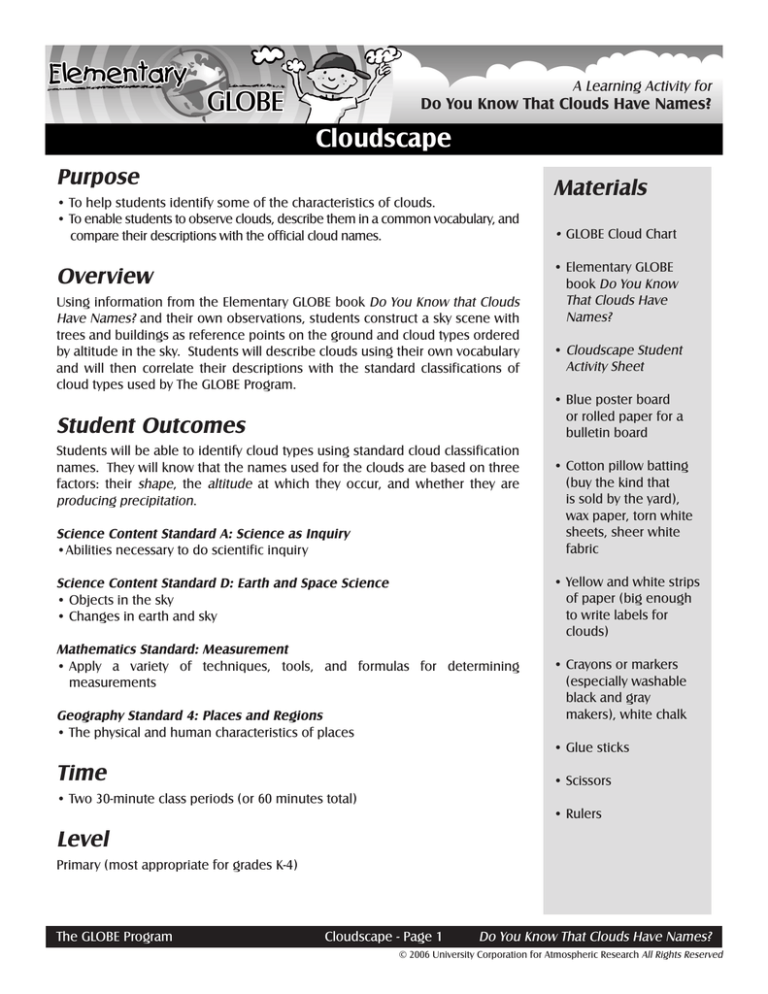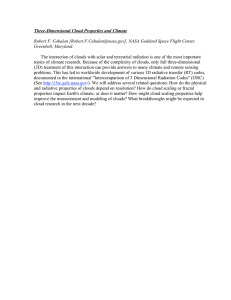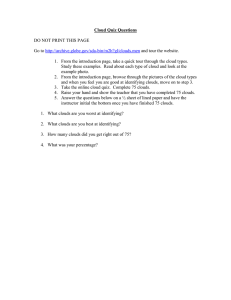Cloudscape Purpose Materials Do You Know That Clouds Have Names?
advertisement

A Learning Activity for Do You Know That Clouds Have Names? Cloudscape Purpose •To help students identify some of the characteristics of clouds. •To enable students to observe clouds, describe them in a common vocabulary, and compare their descriptions with the official cloud names. Overview Using information from the Elementary GLOBE book Do You Know that Clouds Have Names? and their own observations, students construct a sky scene with trees and buildings as reference points on the ground and cloud types ordered by altitude in the sky. Students will describe clouds using their own vocabulary and will then correlate their descriptions with the standard classifications of cloud types used by The GLOBE Program. Student Outcomes Students will be able to identify cloud types using standard cloud classification names. They will know that the names used for the clouds are based on three factors: their shape, the altitude at which they occur, and whether they are producing precipitation. Science Content Standard A: Science as Inquiry •Abilities necessary to do scientific inquiry Materials •GLOBE Cloud Chart •Elementary GLOBE book Do You Know That Clouds Have Names? •Cloudscape Student Activity Sheet •Blue poster board or rolled paper for a bulletin board •Cotton pillow batting (buy the kind that is sold by the yard), wax paper, torn white sheets, sheer white fabric •Yellow and white strips of paper (big enough to write labels for clouds) Science Content Standard D: Earth and Space Science •Objects in the sky •Changes in earth and sky Mathematics Standard: Measurement •Apply a variety of techniques, tools, and formulas for determining measurements Geography Standard 4: Places and Regions •The physical and human characteristics of places •Crayons or markers (especially washable black and gray makers), white chalk •Glue sticks Time •Scissors •Two 30-minute class periods (or 60 minutes total) •Rulers Level Primary (most appropriate for grades K-4) The GLOBE Program Cloudscape - Page 1 Do You Know That Clouds Have Names? © 2006 University Corporation for Atmospheric Research All Rights Reserved Preparation of the cloud’s base, and whether it is producing precipitation. •Read the Elementary GLOBE book Do You Know That Clouds Have Names? – either read it to the class or have students read it to themselves. The book can be downloaded from www.globe.gov/ elementaryglobe. 1. Clouds come in three basic shapes: •cumulus clouds (heaped and puffy) •stratus clouds (layered) •cirrus clouds (wispy) •Make examples of the different types of clouds with the same materials the students will use. Having visual examples will help the students with this activity. 2.Clouds occur in three altitude ranges (specifically, the altitude of the cloud base). The following are cloud heights for middle latitudes: Teacher’s Notes High clouds (above 6,000 m), designated by “cirrus or cirro-” and made of ice • Cirrus • Cirrocumulus • Cirrostratus Accurate weather forecasting starts with careful and consistent observations. The human eye represents one of the best (and least expensive) weather instruments. Much of what we know about the weather is a result of direct human observation conducted over thousands of years. Although being able to identify clouds is useful in itself, observing clouds on a regular basis and keeping track of the weather associated with certain kinds of clouds will show students the connection between cloud types and weather. Middle clouds (2,000 - 6,000 m), designated by “alto-” and made of water or ice (depending on the season) • Altocumulus • Altostratus Recognizing cloud types can help you predict the kind of weather to expect in the near future. We will not describe those connections here, but there are numerous weather books that can help you and your students complete that task. Inviting a local meteorologist to visit your class and talk with the students is a sure way to stimulate interest in the relationship between clouds and weather patterns. Note: While both cumulus and cumulonimbus clouds may have their bases starting below 2,000 m, they often grow thick enough to extend into the high range. Thus, they are often referred to as “clouds of vertical development.” Only high clouds are wispy and so the term cirrus has become synonymous with wispy as well as referring to high clouds. In this activity, allow the students to be creative in describing the different cloud types in their own words. Then, provide them with the following information so they can identify clouds with their official names. This background information can also be found in Do You Know That Clouds Have Names? The GLOBE Protocols ask you to identify ten common types of clouds. The names used for the clouds are based on three factors: the shape, the altitude The GLOBE Program Low clouds (below 2,000 m), made of water • Stratus • Nimbostratus • Cumulus • Stratocumulus • Cumulonimbus 3.Clouds whose names incorporate the word “nimbus” or the prefix “nimbo-” are clouds from which precipitation is falling. 4.Contrails are linear clouds made of ice crystals formed around small particles in jet aircraft exhaust. The word “contrail” is an abbreviation of the term “condensation trail”. These are indeed clouds, caused directly by human activity, and are of great interest to researchers. We distinguish three subtypes: Cloudscape - Page 2 Do You Know That Clouds Have Names? © 2006 University Corporation for Atmospheric Research All Rights Reserved • Short-lived contrails: obvious tail behind a plane; Do not remain after plane passes; Figure 1. Short-lived contrail (Image: NASA) • Persistent, non-spreading contrails: obvious contrails (linear, narrow features) that do not appear to dissipate significantly, or to show signs of spreading, and that remain long after the airplanes that created them have left the area; What To Do and How To Do It 1.On a wall or a bulletin board, construct a sky scene (like a mural) with the class using poster board or a roll of paper. Be sure to include buildings that are to scale and trees at the bottom of the scene to provide a sense of horizon. This will serve as a reference to decide if the clouds are low, high, or someplace in between. On one side of the scene, label the different altitudes in the sky, from 0 meters to 8000+ meters. For younger students, also add the words “Low”, “Middle”, and “High” by the altitudes. 2.Divide the students into groups (if you divide them into 11 groups, each group will complete one cloud type or contrails for the wall; otherwise you can divide them into fewer groups and have each group do more than one cloud type.) Give each group a cloud type to work on. Share examples of different clouds made by the teacher. 3.Explain to the students what they need to do for each section of the Cloudscape Student Activity Sheet. They should use their own words to describe their cloud in each category: •Color: white, milky, grey, silvery, mixed, black, etc. •Height in sky: low, medium, high Figure 2. Persistent, non-spreading contrail (Image: NASA) •Size: small, large, heavy, light, dense, thick, etc. • Persistent, spreading contrails: obvious linear cirrocumulus or cirrus-type clouds with a diffuse appearance. •Shape: patchy, fluffy, thin, thick, flat, etc. •Other features: lets sunlight through, blocks sunlight, covers the whole sky, is in layers, is moving, etc. •One-word description: thunderclouds, menacing, threatening, gloomy, enveloping, beautiful, streaked, foggy, bubbly, scattered, moving, swirling, scary, etc. Figure 3. Persistent, spreading contrail (Image: NASA) The GLOBE Program 4.Once the students have completed their description, have them write the name of their cloud on the white label and the one-word description for their cloud type on the yellow label. Then, have them construct their cloud out of sections of cotton pillow batting or other materials provided. If their cloud isn’t just white in color they can use washable grey Cloudscape - Page 3 Do You Know That Clouds Have Names? © 2006 University Corporation for Atmospheric Research All Rights Reserved or black markers to shade the cloud. 5.Once all of the groups have completed these tasks, have each group make a short presentation describing their cloud type and then have them place their cotton cloud and its labels on the sky scene (see Figure 4). 6.Keep the sky scene up in your classroom so the students can use it as a resource every day when making cloud observations. props for the students to use. Younger students might like to make individual clouds on their own small pieces of blue paper. They can add them to the class’ cloudscape or bring them home. Older students can correlate cloud types with the appearance of certain types of weather. See the Cloud Watch Learning Activity in the GLOBE Teacher’s Guide. Students can also pay attention to the sequence of cloud types over the course of several days and can investigate the factors that cause clouds to form. Further Investigations •Cloud Poetry: Have your students write poetry about clouds. Use the list of descriptive words they created for this activity and ask the students if there are any other words they would like to include in the list. Then have them write poetry answering questions like the following: What does the cloud look like? What does it do? How does it make you feel? They can also draw an illustration to go with their poem. •Memory Game: Create cloud “memory” games to practice identification skills. Have each student create a set of index cards that includes each of the ten cloud types. A second set of cards includes illustrations of each type. Have pairs of students turn the cards face down. Partners alternate turning over two cards at a time, attempting to locate a match. A successful match results in another turn; play continues until all cards have been matched. The student with the most matched pairs wins. •GLOBE Cloud Protocol: Start making cloud observations as a class to submit to GLOBE. See the GLOBE Teacher’s Guide (www.globe.gov) for more information on the Cloud Protocols, formulating a research question, and collecting cloud data. Some good research questions for grades K-2 are: Do clouds relate to the seasons? What is the relationship of rain to clouds? Do clouds always rain? Do clouds relate to air temperature? Figure 4. Example of Cloudscape sky scene Adaptations for Younger and Older Students Younger students can act out the traits of the different cloud types. Provide fabric, cotton, gauze, and other The GLOBE Program •Cloud Journal: Have each student keep a weather journal and record cloud types as part of their daily observations. Cloudscape - Page 4 Do You Know That Clouds Have Names? © 2006 University Corporation for Atmospheric Research All Rights Reserved Do You Know That Clouds Have Names? NAME:________________________________ Cloudscape Student Activity Sheet © 2006 University Corporation for Atmospheric Research All Rights Reserved








